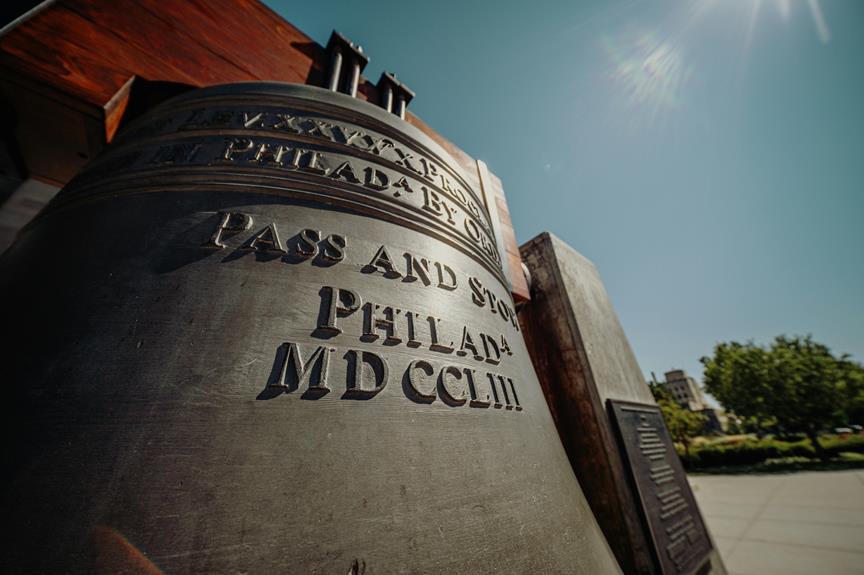The Auschwitz Museum in Poland stands as an enduring monument to the somber chapters of history that unfolded within its walls. Stepping onto the grounds of this solemn site is akin to entering a portal connecting the present to a haunting past. As visitors traverse the museum's exhibits and pay homage at the memorial sites, they are confronted with the stark realities of human suffering and resilience. The impact of this experience lingers long after departing the museum, prompting profound contemplation on the depths of human depravity and the enduring power of remembrance.
Key Takeaways
- Auschwitz Museum in Poland is situated on the grounds of the former Auschwitz concentration camp.
- The museum offers structured tours, interactive displays, and educational programs for visitors.
- Permanent exhibits showcase personal stories, educating about the Holocaust's human cost.
- Memorial sites within the complex honor victims and preserve the tragic history.
- Resources like guidebooks, workshops, and lectures enhance visitors' understanding of the Holocaust.
Historical Background
With a legacy that bears witness to the atrocities of the Holocaust during World War II, the historical background of the Auschwitz Museum in Poland serves as a poignant reminder of the horrors of the past. The museum stands on the grounds of the Auschwitz concentration camp, which was established by the Nazis during their occupation of Poland. This site, with its dark history, serves as a somber acknowledgment to the millions of lives lost during the Holocaust.
During the Nazi occupation, Auschwitz became one of the most notorious sites where the Holocaust atrocities unfolded. The camp was initially set up to imprison Polish political prisoners, but it later evolved into a center for mass extermination of Jews, Roma, Soviet prisoners of war, and others deemed undesirable by the Nazi regime. The systematic genocide that took place within the camp's walls is a stark reminder of the depths of human cruelty and the importance of never forgetting the past.
Visitors to the Auschwitz Museum have the opportunity to witness firsthand the remnants of this tragic history. The museum houses exhibitions that detail the experiences of those who were imprisoned and killed at Auschwitz, as well as artifacts that serve as tangible reminders of the atrocities committed. Through education and remembrance, the Auschwitz Museum stands as a symbol of the resilience of those who survived and a beacon of hope for a future free from such horrors.
Museum Layout
The layout of the Auschwitz Museum in Poland intricately guides visitors through the haunting remnants of the former concentration camp, offering a structured and immersive experience that honors the memory of those who suffered there. The museum's design allows for a chronological journey, starting with the introduction to the camp's history and gradual progression through the various sections.
Interactive displays are strategically placed throughout the museum, providing visitors with a more engaging and informative experience. These displays offer a deeper understanding of the historical context, personal stories of survivors, and the overall impact of the Holocaust. Through the use of multimedia elements, visitors can explore different aspects of life in the camp, further enhancing their knowledge and empathy.
Educational programs play a crucial role in the museum layout, offering guided tours, lectures, and workshops for visitors to explore further into the history and significance of Auschwitz. These programs provide a platform for dialogue, reflection, and learning, ensuring that the memory of the victims is preserved and shared with future generations.
Permanent Exhibits
Numerous thought-provoking exhibits within the Auschwitz Museum in Poland meticulously depict the harrowing realities of the Holocaust, offering visitors a profound insight into the atrocities that occurred at the concentration camp. The permanent exhibits at Auschwitz are designed to be both educational and emotionally impactful, ensuring that the memory of the victims is preserved and that future generations learn from the past.
One of the most striking features of the permanent exhibits is the use of interactive displays. These exhibits allow visitors to engage with the history of the Holocaust in a hands-on manner, making the experience more immersive and memorable. Through these interactive displays, visitors can gain a deeper understanding of the events that took place at Auschwitz and the impact they had on the world.
Another key aspect of the permanent exhibits is the inclusion of personal stories. By showcasing individual accounts of survival, loss, and resilience, the museum humanizes the victims of the Holocaust and brings their experiences to life. These personal stories serve as a powerful reminder of the human cost of hatred and discrimination, urging visitors to reflect on the importance of tolerance and understanding in today's world.
To provide a clearer overview, the table below highlights the key elements of the permanent exhibits at Auschwitz:
| Feature | Description | Impact |
|---|---|---|
| Interactive Displays | Hands-on engagement with history | Immersive experience |
| Personal Stories | Individual accounts of survival and loss | Humanizing the victims |
| Educational Content | Detailed information on Holocaust history | Promoting understanding and remembrance |
Memorial Sites
Located within the Auschwitz Museum complex in Poland are solemn memorial sites that serve as poignant reminders of the tragic history that unfolded within the walls of the former concentration camp. These sites stand as proofs to the millions of lives lost during one of the darkest periods in human history.
The following list provides insight into the significance of these memorial sites:
- Preservation Efforts: The Auschwitz Museum has undertaken extensive preservation efforts to maintain the authenticity and integrity of the memorial sites. Through meticulous conservation work, the museum guarantees that future generations can bear witness to the atrocities committed during the Holocaust and continue to learn from this painful chapter in history.
- Educational Programs: The memorial sites at Auschwitz serve as educational tools to enlighten visitors about the horrors of the Holocaust. Educational programs, guided tours, and exhibitions offer a thorough understanding of the events that transpired at the concentration camp, fostering a sense of remembrance and reflection among visitors.
- Symbolic Remembrance: Each memorial site within the Auschwitz Museum complex holds a symbolic significance that honors the memory of the victims. From the haunting remains of the gas chambers to the solemn memorials dedicated to those who perished, these sites provide a space for contemplation and pay homage to the individuals who suffered unimaginable atrocities.
Visitor Information
Within the Auschwitz Museum complex in Poland, visitors can access essential information to enhance their understanding of the historical significance of the memorial sites. The museum offers a variety of resources to enrich the visitor experience and provide educational insights into the atrocities that occurred during the Holocaust.
Visitor Information and Educational Resources
To facilitate a meaningful visit, the Auschwitz Museum provides visitors with educational materials and resources. Below is a table highlighting the key resources available:
| Resource | Description | Location |
|---|---|---|
| Guidebooks | Detailed information about the memorial sites | Visitor Center |
| Audio Guides | Narration to provide historical context | Rental at Entrance |
| Exhibitions | Displays showcasing artifacts and stories | Throughout the Museum |
| Educational Programs | Workshops and lectures for in-depth learning | Visitor Center |
These resources aim to deepen visitors' understanding of the tragic events that transpired at Auschwitz. By engaging with these educational tools, individuals can gain a more profound insight into the historical significance of the memorial sites and the importance of honoring the memory of the victims. The museum's commitment to providing thorough visitor information and educational resources underscores its dedication to preserving the memory of those who suffered during one of the darkest periods in human history.
Impact and Reflection
Reflecting on the historical significance of the Auschwitz Museum in Poland reveals profound insights into the impact of the Holocaust on collective memory and global awareness. The emotional response elicited by the museum's exhibits and preserved grounds serves as a stark reminder of the atrocities committed during World War II.
Moreover, the educational significance of the museum lies in its ability to educate visitors about the horrors of the Holocaust and the importance of upholding human rights and dignity. Here are three key points that highlight the impact and reflection associated with the Auschwitz Museum:
- Preservation of History: The Auschwitz Museum stands as a somber memorial to the millions of lives lost during the Holocaust, preserving the memory of those who perished and ensuring that future generations never forget the horrors of genocide.
- Promotion of Empathy: By providing a glimpse into the harsh realities faced by prisoners in the concentration camp, the museum fosters empathy among visitors, encouraging them to reflect on the importance of tolerance, compassion, and the safeguarding of human rights.
- Global Awareness: The international recognition of Auschwitz as a symbol of remembrance and reflection underscores the importance of global awareness in preventing similar atrocities from occurring in the future. The museum serves as a poignant reminder of the consequences of hatred, discrimination, and indifference, urging individuals worldwide to actively promote peace, understanding, and unity.
Frequently Asked Questions
How Has the Local Community Been Involved With the Auschwitz Museum?
Community engagement at the museum is fostered through various volunteer programs. These initiatives enable local residents to actively participate in preserving historical heritage and educating visitors.
Are There Any Ongoing Research Projects Related to the Museum?
In the domain of historical preservation, ongoing research collaborations play a crucial role in advancing our understanding of past events and cultural significance.
These endeavors not only contribute to the enrichment of knowledge but also aid in the preservation efforts of historical sites and artifacts.
Through meticulous study and analysis, researchers continually work to unearth new insights and guarantee the legacy of significant landmarks endures for generations to come.
What Is the Significance of Specific Artifacts Not on Display?
The significance of specific artifacts not on display lies in their preservation as historical treasures. These hidden artifacts hold immense value in understanding the past and enriching knowledge.
How Does the Museum Handle Controversial Historical Topics?
When handling controversial historical topics, museums must balance sensitivity and accuracy. By presenting multiple historical perspectives, museums can provide a thorough view of complex events.
Educational resources play an important role in fostering understanding and critical thinking among visitors. Engaging with controversial topics encourages dialogue and reflection, promoting a deeper understanding of the past.
It is essential for museums to approach these subjects with care and objectivity to facilitate meaningful discourse.
Are There Any Virtual Tour Options Available for Remote Visitors?
Virtual reality and interactive experiences are transforming the landscape of remote visits to historical sites. By utilizing cutting-edge technology, visitors can immerse themselves in detailed virtual tours that provide a sense of presence and engagement.
These experiences offer a unique opportunity to explore landmarks and museums from anywhere in the world, providing access to cultural and historical sites that may otherwise be inaccessible.
Conclusion
To sum up, the Auschwitz Museum in Poland stands as a solemn beacon of remembrance, shedding light on the dark depths of human cruelty.
Like a haunting echo of history, the museum serves as a mirror reflecting the horrors of the past, urging visitors to confront the brutal reality of the Holocaust.
It is a stark reminder of the importance of preserving the memory of those who suffered, ensuring that their stories are never forgotten.


